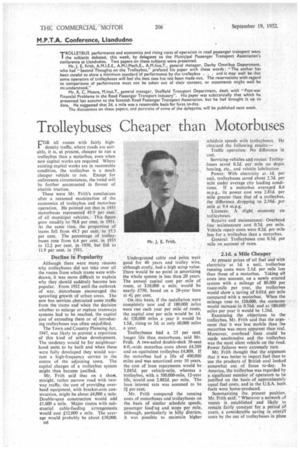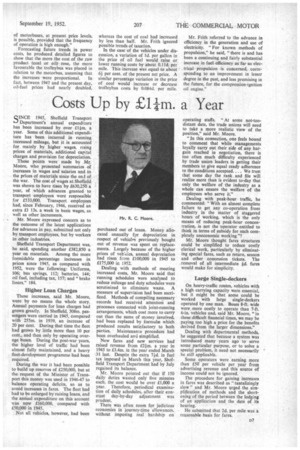Trolleybuses Cheaper than Motorbuses
Page 80

Page 81

If you've noticed an error in this article please click here to report it so we can fix it.
CDR all routes with fairly high'. density traffic, where roads are suitable, it is, at present, cheaper to run a trolleybus than a motorbus, even when new capital works are required. Where existing capital works arc in reasonable condition, the trolleybus is a much cheaper vehicle to run. Except for unforeseen circumstances, the trend will be further accentuated in favour of electric traction.
These were Mr. Frith's conclusions after a reasoned examination of the economics of trolleybus and motorbus operation. He pointed out that in 1935 motorbuses represented 43.9 per cent. of all municipal vehicles. This figure grew steadily to 70.8 per cent. in 1951. At the same time, the proportion of trams fell from 49.7 per cent. to 17.3 per cent. The percentage of trolleybuses rose from 6.4 per cent. in 1935 to 12.2 per cent. in •1950, but fell to 11.9 per cent. in 1951.
Decline in Popularity
Although there were many reasons why trolleybuses did not take over all the routes from which trams were withdrawn, it was more difficult to explain why they should suddenly become less popular. From 1932 until the outbreak of war, motorbuses encouraged the sprawling growth of urban areas. The new bus services abstracted some traffic from the trams and when the decision whether to enlarge or replace tramways systems had to be reached, the capital cost of extending them or of introducing trolleybuses was often unjustified.
The Town and Country Planning Act, 1947, was likely to prevent a repetition of this kind of urban development. The tendency would be for neighbourhood units to be built and when these were fully developed they would warrant a high-frequency service to the centre of the adjoining town, The capital charges of a trolleybus system might then become justified.
Mr. Frith said that on a show, straight, rather narrow road with twoway traffic. the cost of providing overhead equipment, with bracket-arm construction, might be about £.4,000 a mile. Double-span construction would add £1,600 a mile. Major routes with substantial cable-feeding arrangements would cost £12,000 a mile. The average would probably be about £10,000.
Underground cable and poles were good for 40 years and trolley wire, although costly, had a high scrap value. There would be no point in amortizing the whole system in less than 20 years. The annual capital cost per mile of route, at 110,000 a mile, would be nearly £750, based on a 20-year loan at4.1 per cent.
On this basis, if the installation were completely new and if 180,000 miles were run each year per mile of route, the capital cost per mile would be Id. At 120,000 miles a year it would be 1.5d., rising to 3d, at only 60,000 miles a year.
Trolleybuses had a 25 per cent. longer life than motorbuses, said Mr. Frith. A two-axled double-deck 56-seat 8-ft.-wide motorbus costs about £4,200 and an equivalent trolleybus £4,800. If the motorbus had a life of 400,000 miles and was amortized over 10 years. the cost of loan repayments would be 3.045d. per vehicle-mile, whereas a trolleybus, with a 500,000-mile, 12-year life, would cost 2.882d. per mile. The loan interest rate was assumed to be 31 per cent.
Mr. Frith compared the running costs of motorbuses and trolleybuses on the basis of similar schedule speeds, passenger load.ng and stops per mile, although, particularly in hilly districts, it was possible to maintain higher schedule speeds with trolleybuses. He obtained the following results:—
Traffic operation: No difference in cost.
Servicing vehicles and routes: Trolleybuses saved 0.2d. per mile on depot heating, etc., and vehicle lubrication Power: With electricity at , Id. per unit, trolleybuses saved about 2.7d. per mile under average city loading conditions. If a motorbus averaged 8.6 m.p.g., its power cost was 2.81d. per mile greater than that of a trolleybus, the difference dropping to 2.56d. per mile at 9.4 m.p.g.
Licences: A slight economy on trolleybuses.
Repairs and maintenance: Overhead line maintenance cost 0.7d. per mile. Vehicle repair costs were 0.2d, per mile less for a trolleybus than a motorbus.
General: Trolleybuses cost 0.3d. per mile on account of rates.
a Mile Cheaper
At present prices of oil fuel and with electricity at Id. a unit, trolleybus running costs were 2.1d. per mile less than those of a motorbus. Taking all costs into account, on a newly erected system with a mileage of 80,000 per route-mile per year, the trolleybus would show a saving of 0.01d. per mile compared with a motorbus. When the mileage rose to 120,000, the economy would increase to 0.76d. and at 180,000 miles per year it would be 1.26d.
Examining the objections to the trolleybus, Mr. Frith said that the argument that it was less mobile than the motorbus was more apparent than real. Moreover, overhead lines could be made unobtrusive and the trolleybus was the most silent vehicle on the road. Power failures were extremely rare.
Mr. Frith thought that the argument that it was better to import fuel than to use the products of British coal looked somewhat out of focus to-day. In America, the trolleybus was regarded by a significant number of operators to be justified on the basis of approximately equal fuel costs, and in the U.S.A. both fuels were home-produced.
Summarizing the present position, Mr. Frith said: "Wherever a network of routes is established and likely to remain fairly constant for a period of years, a considerable saving in overall costs by the use of trolleybuses in place
of motorbuses, at present price levels, is possible, provided that the frequency of operation is high enough."
Forecasting future trends in power costs, he produced detailed figures to show that the more the cost of the raw product (coal or oil) rose, the more favourable the trolleybus was placed in relation to the motorbus, assuming that the increases were proportional. In fact, between 1947 and the present day, oil-fuel prices had nearly doubled, whereas the cost of coal had increased by less than half. Mr. Frith ignored possible trends of taxation.
In the case of the vehicles under discussion, a variation of Id. per gallon in the price of oil fuel would raise or lower running costs by about 0.11d. per mile. This increase was equal to about 6,1 per cent, of the present net price. A similar percentage variation in the price of coal would increase or decrease trolleybus costs by 0.084d. per mile.
Mr. Frith referred to the advance in efficiency in the generation and use of electricity. "For known methods of propulsion," he said, "there is and has been a continuing and fairly substantial increase in fuel efficiency as far as electrical propulsion is concerned, corresponding to an improvement in lesser degree in the past, and less promising in the future, for the compression-ignition oil engine."




































































































































































